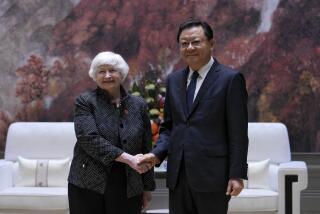In Trade, Globalization Can Divide Old Friends
Allies for decades in the battle to keep cheap foreign goods off U.S. shelves, domestic apparel and textile makers now find themselves on opposing sides over Chinaâs controversial effort to join the World Trade Organization.
U.S. trade negotiators, under pressure from American textile makers, are trying to persuade China to rein in its mammoth textile and apparel industry as part of a final deal to get China into the global trade group.
But in a sharp departure, the increasingly globalized members of the American Apparel Manufacturers Assn. now support Chinaâs position that it be allowed to join other WTO nations scheduled to eliminate all apparel and textile quotas in 2005. Those quotas restrict the number of products a nation can export.
The collapse of this powerful marriage between U.S. textile and apparel manufacturers demonstrates how dramatically globalization is undercutting protectionist sentiments in even the most heavily insulated parts of the U.S. economy. The two industries still employ 1.2 million Americans after years of cutbacks.
Over the last three decades, the U.S. textile manufacturers, which produce yarn and fabric, have invested heavily in modernizing their plants, enabling them to maintain more of their production in the U.S.
But U.S. apparel makers, which rely on a large work force to cut and assemble the textiles into shirts, dresses and shoes, have responded to foreign competition by seeking out cheaper places to make their goods.
Many have closed their U.S. factories and begun subcontracting in Asia or Latin America or setting up plants in Mexico that can ship duty-free into the U.S. under the North American Free Trade Agreement.
So although the labor-intensive U.S. apparel makers face more immediate threats from Chinese competitors armed with a huge low-wage work force, they are also much better prepared to go global. Domestic textile manufacturers, on the other hand, will lose their most important customers if U.S. production moves overseas.
âIn the â80s we were part of the crowd trying to pass textile quota legislation,â says Larry Martin, director of the Washington-based AAMA, whose members include companies such as Liz Claiborne Inc., Jockey International Inc. and Haggar Clothing Co. âNow we realize the futility of that.â
Even with the defection of their longtime ally, the U.S. textile manufacturers remain a powerful trade lobby, thanks to their concentration in politically powerful Southern states and their ties to labor unions.
*
Brenda Jacobs, a Washington lawyer specializing in trade issues, says China is unlikely to give ground on textiles and apparel, its most lucrative export sector, given the criticism it already faces from other industries back home unhappy with the countryâs WTO concessions.
âItâs an awkward spot for negotiation,â Jacobs says. âThe Chinese have given up a great deal on agriculture and other sectors, and one thing they canât go back on is textiles.â
That increases the likelihood that this issue could become a stumbling block to finalizing a deal that would enable China to enter the WTO before Novemberâs ministerial meeting in Seattle.
âThe economic significance of the textile issue is far greater to China than the U.S., but the political question is quite large for both countries,â says another Washington lobbyist familiar with the talks.
There is little doubt that Chinaâs share of the U.S. apparel and textile markets would significantly increase once import restrictions were lifted, given its abundant raw materials, low-cost labor force and increased efficiency and quality.
But there is sharp disagreement over how this flood of low-cost Chinese goods would affect the U.S. economy and what can or should be done to protect those industries threatened by the change.
As with many trade issues, the positive impact of lower-priced Chinese imports and increased jobs in shipping and trade is broadly distributed across the United States, whereas the pain is largely concentrated in a single industry--in this case textiles and apparel--and thus is more visible.
If China joins the other WTO nations in eliminating all quotas in 2005, it would gain a slightly expanded share of the U.S. textile market and a whopping 30% of the apparel market, compared with the 12% it holds today, according to the International Trade Commission.
Although the federal agency acknowledges some âadverse effectsâ on U.S. workers, particularly in apparel, it expects the lifting of Chinaâs quotas to be largely beneficial.
The ITC estimates that increased textile and apparel trade resulting from Chinaâs entry into the WTO would add about $1.9 billion to the U.S. gross national product in 2006, because of increased efficiency, lower-priced goods and other factors. U.S. makers of textile-related machinery and equipment, for example, would enjoy an extra $300 million in exports to China as that country ramps up production.
The ITC and others argue that most of Chinaâs gains in the U.S. textile and apparel market would be at the expense of other low-cost countries rather than U.S. producers, who tend to specialize in more technically sophisticated products.
âWhether itâs India or Pakistan or China, someone is going to make those inroads into the U.S. market,â says Jim Langlois, a vice president at Werner International, a consulting firm specializing in textiles and apparel.
But U.S. textile firms claim that they would be devastated if Chinaâs powerful exporters were unleashed here too soon, because U.S. apparel makers represent the bulk of their business. If the apparel business moves to China, then the textile orders are likely to follow, since that country has its own huge textile sector.
âOur problem is that the U.S. apparel industry continues to shrink and to move offshore, and they are our biggest customer,â says Carlos Moore, executive director of the American Textile Manufacturers Institute. âWe need access to the garment-making industries in the developing world, including China.â
The textile trade group claims that textile and apparel manufacturers would lose 154,500 jobs and $7.6 billion in annual sales if Chinaâs quotas should be lifted in 2005 when the other WTO nations go quota-free.
*
In Southern California, apparel and textile employment--now at 124,200--has been dropping for two years as a result of the same competitive forces affecting the industry elsewhere in the U.S. Chinaâs entry would hasten the process, said Jack Kyser, chief economist at the Los Angeles Economic Development Corp.
âTheyâve already seen the writing on the wall,â Kyser said of the regionâs employers. âTheyâre being battered by low-cost competition. Many of them are moving to Mexico.â
Moore wants Chinaâs quotas to remain in place until 2010 to give U.S. manufacturers time to further modernize and expand foreign sales, particularly into Mexico and the Caribbean. The textile group also wants China to reduce its own duties and remove other barriers to foreign products.
Even producers of specialized textiles would be threatened by Chinaâs entry. Doug Ellis, chairman and chief executive of Southern Mills Ltd., an Atlanta-based producer of fire-retardant materials, predicts that more U.S. firms will try to enter his market to escape the fierce competition in lower-priced goods.
âThose that are injured are going to be looking for something else to do, and we catch the ricochet,â Ellis says.
Trade experts point out that the U.S. market will be far more competitive in 2005 with or without China, since other low-cost producers such as India and Pakistan will be operating free of restraints.
To strengthen their own competitiveness, U.S. textile and apparel firms are sending more and more work to Mexico and the Caribbean. Under the North American Free Trade Agreement, Mexican factories are allowed to ship their finished garments to this country duty-free if they use U.S. fabric. A push is underway to extend those benefits to the Caribbean.
Apparel makers have led this drive. Simi Valley-based sportswear company Bugle Boy Industries has reduced its production in China by 80% over the last two years and is manufacturing more than half its fashion denim in Mexico because of the NAFTA benefits, according to William Mow, the firmâs chairman and chief executive.
*
U.S. textile manufacturers also are starting to follow their customers south. Cone Mills and Burlington Industries recently announced plans to open factories in Mexico.
âThis just points to the increased globalization of the production process,â says Dan Griswold, associate director of the Washington-based Cato Institute, a free-trade advocate. âThe good news on the trade front is [that] the number of industries that are dramatically protectionist [is] getting smaller and smaller.â
More to Read
Sign up for Essential California
The most important California stories and recommendations in your inbox every morning.
You may occasionally receive promotional content from the Los Angeles Times.










